
Australia is experiencing a serious weather crisis as Tropical Cyclone Jasper (pictured in the upper right corner) has strengthened to a Category 4 hurricane, leaving the country at risk of abnormally high temperatures and fire danger. According to CNN, the cyclone moving toward the southeastern coast of Australia may strengthen to Category 5.
On Friday, December 8, the cyclone was located 1,195 kilometers northeast of Queensland, with maximum wind speeds of 220 km/h. Its potential route may run through the city of Kearns, home to about 250,000 people.
Due to the heat wave, which is forecast to last until the weekend, some schools were closed on Friday in Sydney, the capital of New South Wales, home to more than 8 million people. The temperature in Sydney could reach 40 degrees Celsius on Saturday, December 9.
The region also has a complete ban on fire starting due to the growing risk of forest fires. A “catastrophic” level of fire danger has been declared in some parts of South Australia. An emergency level of fire danger was also declared in some parts of New South Wales and Victoria.
The heat is expected to ease by the end of the weekend and early next week, but the situation remains tense.
Australia, which is located in the Southern Hemisphere, has seasons that are opposite to those in the Northern Hemisphere, where Ukraine is located. While Ukraine is going through the winter months with low temperatures and snowfall, Australia is currently entering the summer season. Summer in Australia falls on December, January and February, which leads to a significant increase in temperatures throughout the country. This time of year in Australia is often characterized by high temperatures and dry weather, which creates favorable conditions for tropical cyclones to intensify and increases the risk of wildfires. The abnormal heat currently observed in Australia is characteristic of this “summer” period and may be exacerbated by climate change and global warming.
We also recall that Australia suffers from forest fires every year due to climate change. Sometimes these fires cover larger areas.

